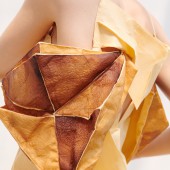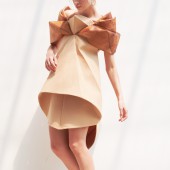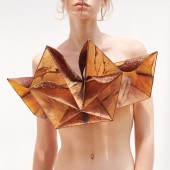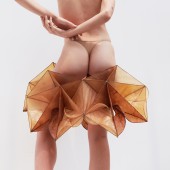
| THE AWARD |
| CATEGORIES |
| REGISTRATION |
| SUBMIT YOUR WORK |
| ENTRY INSTRUCTIONS |
| TERMS & CONDITIONS |
| PUBLICATIONS |
| DATES & FEES |
| METHODOLOGY |
| CONTACT |
| WINNERS |
| PRESS ROOM |
| GET INVOLVED |
| DESIGN PRIZE |
| DESIGN STORE |
| THE AWARD | JURY | CATEGORIES | REGISTRATION | PRESS | WINNERS | PUBLICATIONS | ENTRY INSTRUCTIONS |
Bio Melanin Fibre Fashion by Khajornsak Nakpan |
Home > Winners > Design #127014 >Interview |
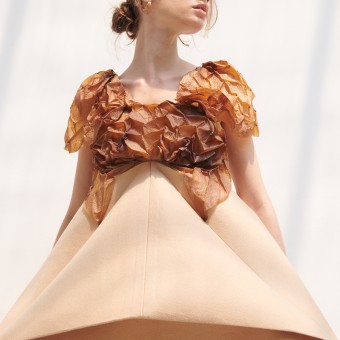 |
|
FS: What is the main principle, idea and inspiration behind your design?
KN: The final material contained melanin pigments similar to human skin tones, with hues comparable to those of people from Thailand.
FS: What has been your main focus in designing this work? Especially what did you want to achieve?
KN: The proposed technology has applications in fashion design, where it can enhance the aesthetics and self-esteem of individuals.
FS: What are your future plans for this award winning design?
KN: This award-winning design help advances Thailand’s national sustainable development, driving creativity through scientific innovation.
FS: How long did it take you to design this particular concept?
KN: Spending 3 years.
FS: Why did you design this particular concept? Was this design commissioned or did you decide to pursuit an inspiration?
KN: A critical duty as an inspiration for designers is to create sustainable products through holistic fashion design.
FS: Is your design being produced or used by another company, or do you plan to sell or lease the production rights or do you intent to produce your work yourself?
KN: There will be several channels for producing this work, such as collaborating with Thai Wacoal Company limited to produce lingerie and nightgowns, continuing the research in order to develop the biomaterial, and creating the aesthetic art pieces.
FS: What made you design this particular type of work?
KN: The use of soil to synthesise a textile substitute is based on research on the integrated cycle of soil along with changes in textile properties owing to Streptomyces (bacteria naturally present in soil), and its use for bio-fibre and melanin production to create a textile substitute of bio-cellulose, with tones similar to those of the human skin .
FS: Where there any other designs and/or designers that helped the influence the design of your work?
KN: In the research by Tina Gorjanc, who extracted DNA from the hair of the renowned fashion designer Alexander McQueen, grew it into the tissue, and developed a skin-like material. As well as biocouture is a research project using nature to suggest an innovative future fashion vision by Suzanne Lee.
FS: Who is the target customer for his design?
KN: The target customer will be a new generation with a conscious mind in nature.
FS: What sets this design apart from other similar or resembling concepts?
KN: The innovative synthesis of melanin from the soil is promising and has the potential to be developed as an alternative material.
FS: How did you come up with the name for this design? What does it mean?
KN: The resulting biodegradable material is safe for human use, and its natural colour promotes self-esteem, reinforcing respect for nature and promoting the relationship between humans and clothing.
FS: Which design tools did you use when you were working on this project?
KN: Practice-based research is the tool for investigating holistic knowledge.
FS: What is the most unique aspect of your design?
KN: The unique aspect was to design and create a speculative product that would give a creative and artistic avenue to meet the criteria of designers, producers, operators, and consumers. This requires a ‘return to nature’ approach ensuring that all stages of production (design, manufacture, transportation, and distribution) are waste-free.
FS: Who did you collaborate with for this design? Did you work with people with technical / specialized skills?
KN: An always advisor named Associate Professor Dr. Supavee Sirinkraporn, an artist jeweller and tutor at Silpakorn University.
FS: What is the role of technology in this particular design?
KN: Biotechnology, integrating aesthetic philosophy.
FS: Is your design influenced by data or analytical research in any way? What kind of research did you conduct for making this design?
KN: Research on melanin synthesis from bacteria or fungi has garnered much interest over the past decade.
FS: What are some of the challenges you faced during the design/realization of your concept?
KN: Streptomyces produced a high amount of melanin, showing the growth of a brownish colony. The physical qualities and chemical mechanisms shown by bacterial melanin are genetically and phenotypically alike to the melanin found in human cells.
FS: How did you decide to submit your design to an international design competition?
KN: To be proved that this work reaches to the international standard point and encounter all over the world comments.
FS: What did you learn or how did you improve yourself during the designing of this work?
KN: The creation of scientific innovation focused on research related to human skin colour, drawing inspiration from groups of Thai people from different regions in the country to create clothes that are appropriate for the most common skin colour. Together with the issue of increasing the value and worth of natural resources is chosen because of the need to develop viable substitute materials. These materials can be used to produce clothes based on comparing melanin from the soil and skin colour.
FS: Any other things you would like to cover that have not been covered in these questions?
KN: The project aims to develop a product that manifests the concept of self-esteem, showing the philosophy and beauty of human skin. A series of garments can promote a positive self-image and a sense of security, which will enhance people's aesthetic values in the future.
FS: Thank you for providing us with this opportunity to interview you.
A' Design Award and Competitions grants rights to press members and bloggers to use parts of this interview. This interview is provided as it is; DesignPRWire and A' Design Award and Competitions cannot be held responsible for the answers given by participating designers.
| SOCIAL |
| + Add to Likes / Favorites | Send to My Email | Comment | View Press-Release |

